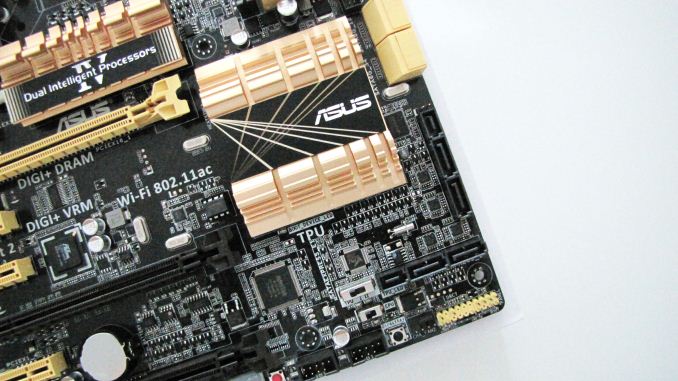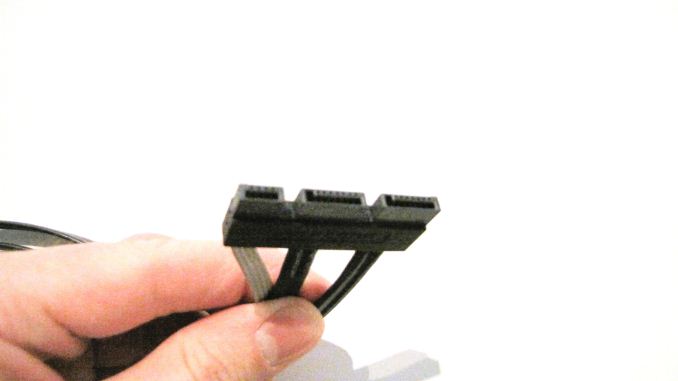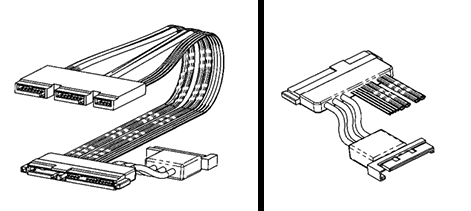Testing SATA Express And Why We Need Faster SSDs
by Kristian Vättö on March 13, 2014 7:00 AM EST- Posted in
- Storage
- SSDs
- Asus
- SATA
- SATA Express
What Is SATA Express?
Officially SATA Express (SATAe from now on) is part of the SATA 3.2 standard. It's not a new command or signaling protocol but merely a specification for a connector that combines both traditional SATA and PCIe signals into one simple connector. As a result SATAe is fully compatible with all existing SATA drives and cables and the only real difference is that the same connector (although not the same SATA cable) can be used with PCIe SSDs.
As SATAe is just a different connector for PCIe, it supports both the PCIe 2.0 and 3.0 standards. I believe most solutions will rely on PCH PCIe lanes for SATAe (like the ASUS board we have), so until Intel upgrades the PCH PCIe to 3.0, SATAe will be limited to ~780MB/s. It's of course possible for motherboard OEMs to route the PCIe for SATAe from the CPU, enabling 3.0 speeds and up to ~1560MB/s of bandwidth, but obviously the PCIe interface of the SSD needs to be 3.0 as well. The SandForce, Marvell, and Samsung designs are all 2.0 but at least OCZ is working on a 3.0 controller that is scheduled for next year.
The board ASUS sent us has two SATAe ports as you can see in the image above. This is a similar port that you should find in a final product once SATAe starts shipping. Notice that the motherboard connector is basically just two SATA ports and a small additional connector—the SATA ports work normally when using a standard SATA cable. It's only when the connector meets the special SATAe cable that PCIe magic starts happening.
ASUS mentioned that the cable is not a final design and may change before retail availability. I suspect we'll see one larger cable instead of three separate ones for esthetic and cable management reasons. As there are no SATAe drives available yet, our cable has the same connector on both ends and the connection to a PCIe drive is provided with the help of a separate SATAe daughterboard. In the final design the other end of the cable will be similar to the current SATA layout (data+power), so it will plug straight into a drive.
That looks like the female part to the SATA connector in your SSD, doesn't it?
Unlike regular PCIe, SATAe does not provide power. This was a surprise for me because I expected SATAe to fully comply with the PCIe spec, which provides up to 25W for x2 and x4 devices. I'm guessing the cable assembly would have become too expensive with the inclusion of power and not all SATA-IO members are happy even with the current SATAe pricing (about $1 in bulk per cable compared to $0.30 for normal SATA cables). As a result, SATAe drives will still source their power straight from the power supply. The SATAe connector is already quite large (about the same size as SATA data + power), so instead of a separate power connector we'll likely see something that looks like this:
In other words, the SATAe cable has a power input, which can be either 15-pin SATA or molex depending on the vendor. The above is just SATA-IO's example/suggestion—they haven't actually made any standard for the power implementation and hence we may see some creative workarounds from OEMs.















131 Comments
View All Comments
SunLord - Thursday, March 13, 2014 - link
I like the idea but they should of rolled there own custom connector not twist the sata connector to meet there needs it's looks stupid. A custom high density connector and cable designed specifically for its task would make far more sense then this hodgepodge but I guess they need to cut comers to "keep costs down" on something already aimed at the high end which is even stupider. A nice clean high density interface with an sata adpater would of been far better.androticus - Thursday, March 13, 2014 - link
Ugh. What an immensely cumbersome and kludgy design.asuglax - Thursday, March 13, 2014 - link
Kristian, I completely agree with your final thoughts. I would actually take it a step further and say that Intel should completely do away with the DMI interface and corresponding PCH; they should limit the I/O off the processor to as many as possible PCI-e lanes, 3 DisplayPort (which can be exposed as dual-mode), and however many memory channels. Enterprise could have QPI, additionally. I would like to see I/O controllers embedded into the physical interconnects where PCI-e could be routed to the interconnects and however many USB, SATA, or other connections could be switched and exposed through the devices (I supposed it could be argued that this could be a PCH in itself, only connected through PCI-e instead of DMI). Security protection measures (such as TPM's functionality) should be built-in to all components and, while being independently operative, be able to communicate with one-another through the presented I/O channels.fteoath64 - Saturday, March 15, 2014 - link
@asuglax: Intel is known and has done this. Provide small incremental adds to the processor and chipset features so they can provide as many iterations of SKUs as they can over a period of time. If they do a radical change, then they risk not being able to manage the incremental changes they wanted. It is a strategy to allows for a large variety of product units, hence expanding the market for themselves. Lately, you see that they have reduced the number of CPU skus while expanded the mobile mobile skus. This is possible since in both market segments they are the majority leader and allows them to maximise profits with minimal changes to production. It is a different strategy for AMD and a completely different one yet for the Arm SoC vendors. Intel's strategy seems like it is coercing the market to move to a place and pace they wanted. The Arm guys just give their best shot on every product they have so we got a lot more than we paid for.You just cannot teach an old dog new tricks.
Babar Javied - Thursday, March 13, 2014 - link
This SATA 3.2 really doesn't make a lot of sense to me and others also seem to agree from when I've read in the comments. Is this supposed to be a temporary thing or the middle man before we get to the good stuff? like SATA 4.0, is that the reason why it's called SATA 3.2?So here is a genuine question. Why not just use Thunderbolt? It is owned by intel and they can implement it into their next chipset(s). Also, Thunderbolt uses PCIe lanes so it is plenty fast without wasting lanes. Sure, the controller and cables are expensive but once it starts to be mass produced they should come down as is common with electronics.
It seems to me that SATA is going though a lot of trouble to bring 3.2 when it is only marginally better. I also get the feeling that SSDs are going to get even faster by using more channels (current standard is 8) and NAND chips (current standard is 16) as they become the new standard in storage. Of course the transition from HDD to SDD is not going to happen overnight but it is going to happen and I get the feeling that the 750MB/s is going to become a bottleneck very quickly.
And finally, by switching to Thunderbolt, we also help kickstart the adoption of this standard and hopefully see it flourish. Allowing us to daisy chain monitors, storage drives (SSDs and HDDs), external graphic cards and so much more.
SirKnobsworth - Thursday, March 13, 2014 - link
There's no point to implementing Thunderbolt internally, which is what SATAe is for. For external purposes you can already buy Thunderbolt SSDs.SittingBull - Thursday, March 13, 2014 - link
I don't feel like you have proven that there is any need for these faster hard drive interfaces, as you hoped to in the title of your article. The need for, let alone the desire for, higher resolution video is anything but proven by anyone that I know of. 4k video offers only dubious benefits, as only very large displays can show the difference between it and 1080p, ie., 70 or 80 inches! The wider colour gamut would be nice but is not really compelling, and those are the only benefits I am aware of. I seriously doubt that the TV or electronics industry are going to be able to sell the 4k idea to the public as a whole. Even 720p is not shown to be lacking until we get into displays larger than 50 inches.It is always nice to read up on the tech of the future and I thank you for explaining the SATAe and other interfaces that are in the works. Eventually these advances will be implemented but I can't see it happening until there is some sort of substantial demand, and your entire article is built on the premise that we will need the bandwidth to support 4k video quite soon. But we don't ... :(
BMNify - Sunday, March 16, 2014 - link
SittingBull , perhaps you should stick your head out of the Native American Law Students offices and look to your alumni of the Indian Institute of Science for inspiration in the tech world today,given that its clear and public knowledge that the NHK/ BBC R&D years of UHD development http://www.bbc.co.uk/rd/blog/2013/06/defining-the-... and now ratified by the International Telecommunication Union are the minimum base for any new Soc design to adhere to and comply with IF they want to actually reuse their current UHD IP for the longest time scales...
the main point is if the PR are not trying to cover up by acts of omission the fact they don't actually comply with the new Rec. 2020 real colour space is better colour coverage due to using 10bits per pixel for UHD-1 consumer grade panels and later UHD-2 12bit grade panels for the 8192×4320 [8K] consumer in 4 years or so.
to put it simply, antiquated Rec. 709 (HDTV and below) 8bit pseudocolor color = only 256 bands of usable colour.
Rec. 2020 real colour space 10bits per pixel= 1000+ bands of usable colour so you get far less banding in lower bit rate encodes/decodes and more compression for a given bit rate so a better higher visual quality at smaller size.
as it happens, NHK announced they are to give another UHD-2/8K 3840 pixels wide by 2160 pixels high Broadcast Demo at the coming NAB Show,"Japanese public broadcaster NHK is planning to give a demonstration of "8K" resolution content over at single 6MHz bandwidth UHF TV channel at the National Association of Broadcasters (NAB) Show coming up in Las Vegas, Nevada, April 5 to 10."
In order to transmit the 8K signal, whose raw data requirement is 16 times greater than an HDTV signal, it was necessary to deploy additional technologies These include ultra multi-level orthogonal frequency domain multiplex (OFDM) transmission and dual–polarized multiple input multiple output (MIMO) antennas. This was in addition to image data compression. The broadcast uses 4096-point QAM modulation and MPEG-4 AVC H.264 video coding.
we could also have a debate about how qualcomm and other cortex vendors might finally provide the needed UHD-2 data throughput and far lower power with ether integrated JEDEC Wide IO2 25.6GBps/51.2GBps or Hybrid Memory Cube 2.5D interposer-based architectures,and using MRAM inline computation etc.
did you notice how the ARM SoC with its current NoC (network On Chip) can already beat today's QPI real life data throughput (1Tb/s,2Tb/s etc) at far lower power,never mind the slower MCI as above, they only need to bring that NoC capability to the external interconnect to take advantage of it in any number of IO ports
Popskalius - Friday, March 14, 2014 - link
I haven't even taken my Asus z87 Plus out of its shrink wrap and it's becoming obsolete.SittingBull - Friday, March 14, 2014 - link
I just put together my own system with an Asus Z87 Plus mb, an i7 4770k, 16 GB of RAM and an SSD. It is not and will not be obsolete anytime in the near future, ie., at least 3 years. Worry not. There isn't anything on the horizon our systems won't be able to deal with.